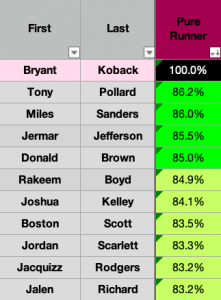Toledo’s Bryant Koback is the next subject in a series in which I evaluate 2022 rookie running backs solely on their ability to run the ball. The Breakout Finder installments can be found here. The PlayerProfiler installments can be found here. If you happened to already catch those and don’t need a refresher on my methodology, feel free to skip to the player-focused analysis.

Toledo’s Bryant Koback is a fifth-year senior who was relatively productive throughout his college career. In his redshirt freshman season, he had over 900 rushing yards. And his yearly Dominator Ratings never dipped below the 50th-percentile among running backs drafted since 2007. At 210-pounds and with a career-best Target Share of 13.7-percent (85th-percentile) to his name, he also has the basic makings of a three-down player. Let’s see how his rushing efficiency numbers stack up to that resumé.
The Metrics
On 679 carries, Bryant Koback‘s team-relative efficiency numbers were fairly modest. He played with teammates who collectively averaged just a 1.92-star rating as high school recruits (9th-percentile). And his career yards per carry exceeded theirs by just 0.39. That’s a 44th-percentile showing in YPC+, and Koback’s 49th-percentile mark in Chunk Rate+ is similarly meh, at just 0.89-percent. Both of those numbers show that Koback was outdoing the per carry efficiency of his backfield mates. But you’d like to see a small school prospect stand out even more.
Koback did post those efficiency numbers while facing heavier box counts than those his teammates faced; by 0.12 defenders on average, 67th-percentile. However, his Box-Adjusted Efficiency Rating of 109.9-percent, while also positive, lands in just the 30th-percentile.
The COVID Factor
One confounding factor making evaluating this running back class difficult is the weirdness brought on by COVID-19 and its various effects on college football in 2020. In the last five years, 10 backs have been drafted after spending at least five years in college; this out of a total 103 drafted. Going back to 2007, the average age of an RB draftee has been 22.57 years; this as of September 1st of their rookie season.
We don’t yet know who will be drafted in this year’s class. But 12 of the 36 backs invited to the 2022 Combine are declaring for the draft after at least five years at school. Further, the average age of running backs in this class will be right around 22.90 on September 1st. The extra season of eligibility granted by the NCAA to account for the 2020 season’s wonkiness is throwing a wrench into conventional notions about how old we should expect our RB prospects to be. There are also surely other effects COVID had on them.
Maybe a guy had a great season on a shortened 2020 schedule. And where in a normal year he would’ve declared for the draft, he might have gone back to school for an extra season due to logistical issues with the scouting process or the lack of exposure that comes from playing fewer games. Maybe a player was stranded under quarantine at home during his school’s offseason program, rendering him unable to work out on campus. Maybe a dude contracted the virus himself, negatively affecting his availability and performance in a season that was important for his draft stock.
In this particular draft, I’m more willing to give guys the benefit of the doubt for declaring late or having seemingly weird 2020 seasons.
Back to the Metrics
That leads us back to Koback, who had a weird 2020 season. On Toledo’s six-game schedule that year, he had 750 yards and 6 TDs from scrimmage. But his rushing efficiency numbers on 123 carries were abysmal. His YPC+ was -1.47 (3rd-percentile) and his Chunk Rate+ was an astonishingly bad -11.58-percent. Which would be the worst mark in my database if it was his career number. I have no idea if the COVID-19 situation had any negative effect on Koback’s play in 2020. But his performance that year was quite the outlier. He maintained positive marks in both YPC+ and Chunk Rate+ in each of his three other seasons.
It’s generally not sound process to ignore a player’s worst season. But for the reasons I outlined before, I’m a bit more willing to do it during this particular draft process. Without his 2020 numbers, Koback’s YPC+ jumps from the 44th-percentile to the 62nd. And his Chunk Rate+ leaves the 34th-percentile in favor of the 78th.
As an open-field runner, Koback was slightly below-average. His career 29.4-percent Breakaway Conversion Rate is a 45th-percentile mark.
Rushing Efficiency Score and Comps
My running back model accounts for all the non-BAE metrics touched on in this article (in addition to overall team quality, offensive line play, rushing volume, and strength of opponent) to generate a composite Rushing Efficiency Score for each player. Koback’s score there is a 43.3 out of 100. In a composite that does account for box count data, he earns a 37.5.
Using those same metrics, I’m able to generate comps as well. While also accounting for an assumed 4.50 40-yard dash at a projected 5-11 and 210-pounds, the following historical prospects are most similar to Koback from a “pure runner” perspective:

Given that I’m using his career numbers here (with 2020 included), there are a surprising amount of actual NFL contributors on this list. Tony Pollard and Miles Sanders are both close matches with similar body types. Pollard, in particular, posted comparable team-relative efficiency numbers while playing with teammates who were of just as low pedigree.
Last Word
Bryant Koback boasts quality size, receiving chops, and production, making him a sneaky three-down player in this running back class. He didn’t get a Combine invite, which doesn’t speak well to the opinion that NFL evaluators have him of him. However, if he’s the guy we saw as an underclassman and in 2021 rather than the galoshes-strapped plodder we saw in 2020, he might be good enough to get a shot with a team anyway. I like him a lot as a taxi squad lottery ticket in this rookie class.


